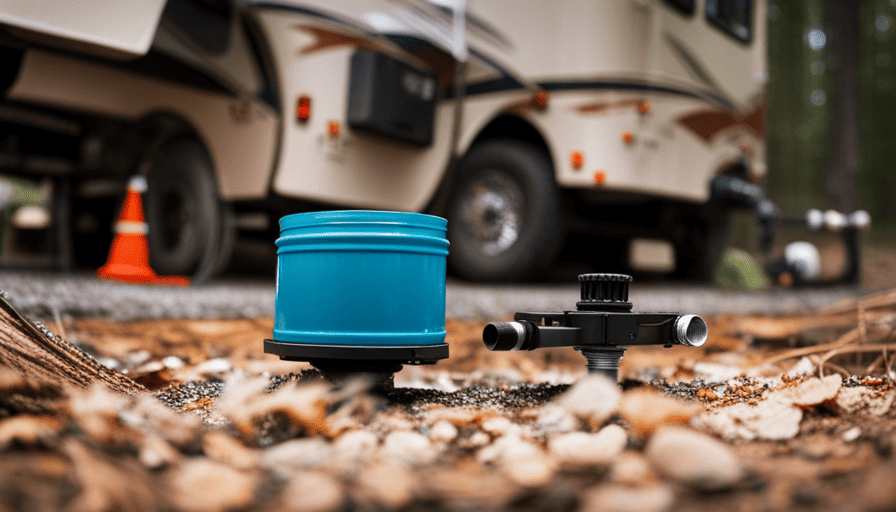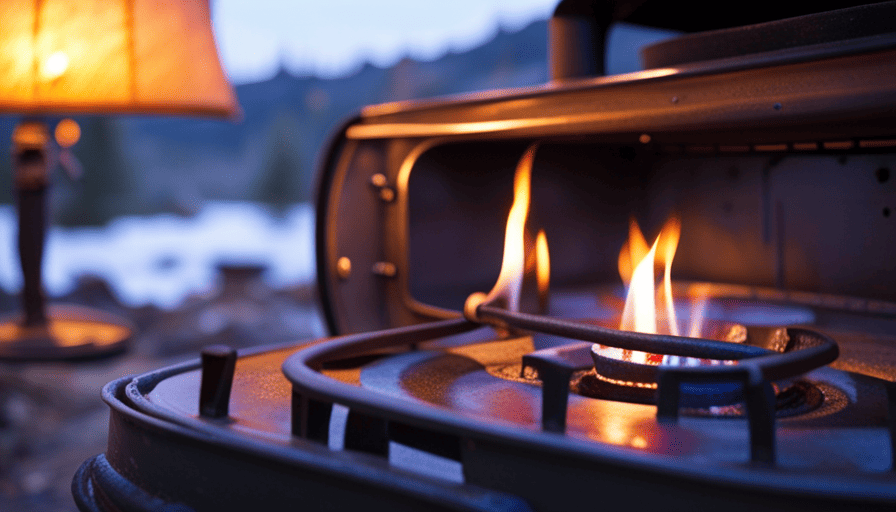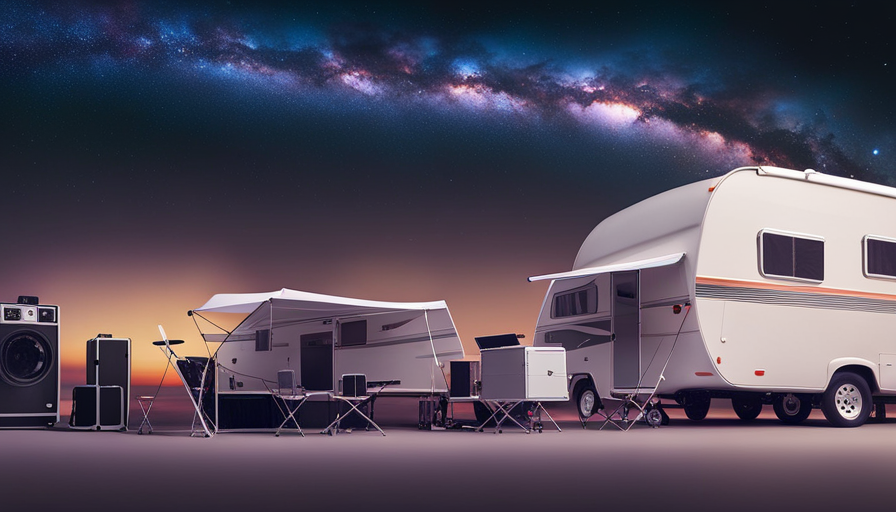So, you’ve become the elated owner of a camper, correct? There’s something genuinely thrilling about having the liberty to journey across the highways and discover unfamiliar territories. However, we have to acknowledge the less appealing duty that falls upon every camper owner: the chore of draining the tanks. Indeed, those remarkable devices that store all the remnants of your journeys.
Now, I know what you’re thinking – ‘Oh boy, I can’t wait to get my hands dirty and deal with all that mess!’ Well, fear not, my fellow adventurers, because I’m here to guide you through the somewhat daunting process of emptying your camper tanks.
From understanding the different tanks to finding the right dump station, and from preparing the tanks for emptying to properly maintaining them, I’ll provide you with all the detailed instructions and technical know-how to make this task a breeze.
So, grab your gloves and let’s get started on this not-so-glamorous yet necessary journey!
Key Takeaways
- Regularly check tank capacities to prevent overfilling and avoid odors and leaks.
- Use biodegradable cleaning products and specialized tank treatments to minimize harm to the environment and control odors.
- Inspect and maintain sewer hose and connections to prevent spills or leaks during emptying.
- Follow campground or park guidelines for gray water disposal and practice proper etiquette at dump stations.
Understand the Different Tanks in Your Camper
Before you hit the road, it’s crucial to understand the different tanks in your camper and how to empty them to ensure a smooth and hassle-free camping experience.
Understanding tank capacities is the first step. Your camper typically has three tanks: the fresh water tank, the gray water tank, and the black water tank. The fresh water tank holds the water you use for cooking, cleaning, and drinking. The gray water tank collects the used water from the shower, sinks, and washing machine. The black water tank stores waste from the toilet.
To maintain the tanks properly, there are a few tips you should follow. First, regularly check the tank capacities to avoid overfilling. Empty the gray water tank before it reaches its maximum capacity to prevent foul odors and potential leaks. Additionally, it’s important to use biodegradable cleaning products to minimize harm to the environment.
Now that you understand the different tanks and their capacities, it’s time to gather the necessary supplies for emptying them.
Gather the Necessary Supplies
To properly empty the tanks on your camper, you’ll need a few essential supplies.
First and foremost, rubber gloves are a must-have to protect your hands from any potential mess.
Next, a sturdy sewer hose is necessary to connect your camper’s holding tank to the dump station.
Lastly, don’t forget to bring a wrench or pliers to ensure a secure connection and prevent any leaks during the process.
With these supplies in hand, you’ll be well-equipped to efficiently empty your camper’s tanks.
Rubber Gloves
Wearing rubber gloves is essential for emptying the tanks on a camper. They not only protect your hands from coming into direct contact with waste and harmful bacteria, but they also provide a barrier against any chemicals that may be present in the tanks. When it comes to proper usage, make sure to choose gloves that fit snugly and are made of a durable material, such as nitrile or latex. Avoid using gloves that are too loose or made of thin material, as they may tear easily. If you prefer not to use rubber gloves, there are alternatives available, such as disposable plastic gloves or even thick gardening gloves. However, keep in mind that these alternatives may not provide the same level of protection.
Moving on to the next step, let’s discuss the sewer hose.
Sewer Hose
Once you’ve secured your rubber gloves, it’s time to connect the sewer hose to the designated outlet for waste disposal.
For example, imagine you’re at a crowded campground and need to quickly and efficiently connect your sewer hose to the dump station without causing any interruptions or delays for other campers. To ensure proper sewer hose maintenance, start by inspecting the hose for any cracks or leaks. If you encounter any issues, replace the hose immediately.
Next, attach one end of the hose securely to the RV’s waste outlet, making sure it’s tightly sealed to prevent any leaks. Then, connect the other end of the hose to the dump station’s inlet, ensuring a secure and airtight connection.
If you encounter any common sewer hose problems, such as clogs or blockages, use a specialized hose cleaner or a plumber’s snake to troubleshoot the issue.
Finally, transition into the subsequent section about ‘wrench or pliers’ by mentioning the importance of having the right tools to ensure a secure connection.
Wrench or Pliers
Using a wrench or pliers, you can easily tighten the connections on your sewer hose to ensure a secure and leak-free setup. Proper maintenance of your wrench is essential to its longevity and effectiveness. Regularly check for any signs of wear or damage, and replace if necessary. Clean the wrench after each use to prevent rust and buildup. For pliers alternatives, consider using channel lock pliers or adjustable wrenches with a wide jaw opening. These tools provide a strong grip and allow you to tighten or loosen connections easily. Remember to always use the right size tool for the job to prevent stripping or damaging the fittings. Now that you have properly secured your sewer hose connections, it’s time to find the dump station.
Find the Dump Station
To easily get rid of waste from your camper tanks, locate the dump station and let it be your saving grace on the road. Finding RV dump stations is essential, and there are a few tips to keep in mind.
Firstly, plan your route in advance and research the locations of dump stations along the way. Many websites and mobile apps provide comprehensive lists of dump stations nationwide. It’s also helpful to ask fellow campers or RV enthusiasts for recommendations.
Once you’ve found a dump station, make sure it can accommodate your camper’s size and has all the necessary amenities, such as water for rinsing. Some dump stations may require a fee, so be prepared to pay.
Additionally, it’s important to follow proper etiquette at dump stations, such as emptying your tanks quickly and cleaning up after yourself.
By finding the right dump station and following these tips, you can efficiently empty your camper tanks and continue your journey.
Now, let’s move on to preparing the tanks for emptying.
Prepare the Tanks for Emptying
Before you bid farewell to your waste, it’s crucial to ensure that your tanks are well-prepared for the upcoming emptying process. Proper camper tank maintenance is essential to prevent tank odors and maintain a clean and functional system. Follow these steps to prepare your tanks for emptying:
-
Flush the tanks: Start by flushing both the black water and gray water tanks with clean water. This will help remove any remaining waste and debris.
-
Add tank treatment: After flushing, add a specialized tank treatment to control odors and break down waste. Make sure to choose a product specifically designed for RV tanks.
-
Check the seals: Inspect the tank seals and connections for any signs of damage or leaks. Replace any worn-out seals to prevent leaks during the emptying process.
-
Close the valves: Ensure that all valves leading to the tanks are tightly closed. This will prevent any accidental spills or leaks while emptying.
-
Secure the caps: Double-check that the caps on both the black water and gray water tanks are securely fastened to avoid any unpleasant surprises.
By properly preparing your tanks, you can ensure a smooth and odor-free emptying process. Now, it’s time to move on to emptying the gray water tank and completing the maintenance routine.
Empty the Gray Water Tank
To empty the gray water tank on my camper, I first connect the sewer hose to the gray water outlet.
Then, I make sure to place the other end of the sewer hose into the dump station hole securely.
Finally, I open the gray water valve and let it drain completely, making sure not to forget any steps to ensure a thorough emptying process.
Connect the Sewer Hose to the Gray Water Outlet
After securing the sewer hose, attach it to the gray water outlet of the camper. Connecting the sewer hose properly is essential for efficient and hygienic emptying of the gray water tank. To ensure a successful connection, follow these steps:
- Align the hose fitting with the gray water outlet.
- Push the hose onto the outlet until it fits snugly.
- Twist the hose clockwise to lock it in place.
- Check for any leaks or loose connections.
Secure the other end of the hose to the dump station hole.
By following these proper disposal methods, you can effectively empty the gray water tank of your camper. Now that the sewer hose is securely connected to the gray water outlet, it’s time to place the other end of the hose into the dump station hole.
Place the Other End of the Sewer Hose into the Dump Station Hole
Alright, now that we’ve successfully connected the sewer hose to the gray water outlet, it’s time to move on to the next step.
In order to properly empty the tanks on your camper, you need to place the other end of the sewer hose into the dump station hole. The dump station is usually located in a designated area of the campground or RV park. It’s important to follow the campground or park’s guidelines regarding the proper disposal methods for gray water.
Once you have located the dump station, carefully insert the other end of the sewer hose into the hole. Make sure it’s securely in place to prevent any spills or leaks.
Now, we’re ready to move on to the next section where we’ll learn how to open the gray water valve and let it drain completely.
Open the Gray Water Valve and Let it Drain Completely
Now, it’s time for you to release the gray water valve and watch as it drains completely, leaving your camper ready for the next adventure. Understanding waste disposal is crucial to maintaining a clean and odor-free tank.
To begin, locate the gray water valve, usually found near the black water valve. Open it by turning the handle counterclockwise. As the valve opens, you’ll hear the sound of rushing water. Ensure that the sewer hose is securely connected to the dump station hole to avoid any spills.
As the gray water drains, it’s essential to keep an eye out for any leaks or blockages. Once the water stops flowing and the tank is empty, close the gray water valve tightly. This step prevents tank odors from escaping and ensures proper sanitation.
Transitioning to empty the black water tank is the next important task in maintaining your camper’s waste system.
Empty the Black Water Tank
To empty the black water tank on my camper, I first connect the sewer hose to the black water outlet.
Then, I carefully place the other end of the sewer hose into the dump station hole, making sure it’s securely in place.
Once everything is set up, I open the black water valve and let it drain completely, ensuring that all waste is properly disposed of.
Connect the Sewer Hose to the Black Water Outlet
First, you’ll need to attach the sewer hose to the black water outlet on your camper to start emptying the tanks. Here’s how to do it properly:
-
Make sure the black water valve is closed to prevent any spills.
-
Take the sewer hose and connect one end to the black water outlet, making sure it’s securely fastened.
-
Attach the other end of the sewer hose to the dump station’s sewer inlet, ensuring a tight connection.
-
Double-check that both ends are securely connected before proceeding.
Now that the sewer hose is properly connected, you can move on to the next step of emptying the tanks. Place the other end of the sewer hose into the dump station hole, making sure it’s securely in place. This will allow for the proper disposal of the waste from your camper’s black water tank.
Place the Other End of the Sewer Hose into the Dump Station Hole
As the sewer hose finds its way into the abyss of the dump station hole, it symbolizes the release and liberation of that which burdens us, allowing for a fresh start and a renewed sense of freedom. To ensure proper dump station etiquette and prevent tank odors, it’s crucial to handle this step with care. Gently insert the other end of the sewer hose into the dump station hole, making sure it’s secure and properly aligned.
Avoid any spills or leaks by double-checking the connection. Remember to always wear protective gloves to maintain cleanliness and hygiene.
Once the hose is securely in place, proceed to the next step of the process: opening the black water valve and letting it drain completely. This will empty the tanks and prepare them for the next adventure, ensuring a seamless camping experience.
Open the Black Water Valve and Let it Drain Completely
Once the sewer hose is securely in place, you’ll hear the satisfying sound of the black water valve opening, as the contents begin their descent into the abyss. To fully understand the drainage system of your camper, it is crucial to know how to properly drain the black water tank. By opening the black water valve, you allow the waste to flow out and prevent any potential clogs in the tank. Make sure to let it drain completely before proceeding to the next step. To ensure a smooth drainage process, it is important to maintain a clear path for the waste to flow. By regularly cleaning and flushing the tanks, you can prevent any build-up and avoid future clogs. With the black water valve open and the tank fully drained, it’s time to move on to the next step of rinsing and cleaning the tanks.
Rinse and Clean the Tanks
To thoroughly rinse and clean the tanks on your camper, start by attaching a hose to the tank’s external valve and allowing the water to flow through, flushing out any remaining waste and debris. This step is crucial in maintaining the hygiene of your tanks and preventing unpleasant odors.
Here are three effective rinse methods to ensure a thorough cleaning:
-
High-pressure rinse: Use a nozzle attachment on your hose to create a powerful stream of water. This’ll help dislodge stubborn waste and debris, ensuring a more thorough clean.
-
Back-and-forth motion: While rinsing, move the hose back and forth inside the tank to reach all corners and crevices. This’ll help remove any residue that may have accumulated in hard-to-reach areas.
-
Repeat the process: After the initial rinse, repeat the process at least two more times to ensure all waste and debris have been thoroughly flushed out. This’ll leave your tanks clean and ready for use.
Now that your tanks are rinsed, it’s time to move on to the next step: disinfect and sanitize. This important process’ll ensure that your tanks aren’t only clean but also free from harmful bacteria and germs.
Disinfect and Sanitize
Now it’s time to give your tanks a thorough disinfecting and sanitizing to ensure they’re squeaky clean and germ-free. Proper maintenance and regular cleaning is essential to prevent the growth of bacteria and maintain the overall hygiene of your camper. Here are some effective disinfecting methods you can use:
| Disinfecting Methods | Materials Needed | Steps to Follow |
|---|---|---|
| Bleach Solution | Bleach, Water, Spray Bottle | 1. Mix 1/4 cup of bleach with 1 gallon of water. 2. Pour the solution into a spray bottle. 3. Spray the solution onto the tank surfaces. 4. Let it sit for 15 minutes. 5. Rinse thoroughly with clean water. |
| Vinegar Solution | White Vinegar, Water, Spray Bottle | 1. Mix equal parts of vinegar and water in a spray bottle. 2. Spray the solution onto the tank surfaces. 3. Allow it to sit for 30 minutes. 4. Rinse thoroughly with clean water. |
| RV Tank Cleaner | RV Tank Cleaner Product, Water | 1. Follow the instructions provided by the manufacturer for the specific product. 2. Apply the cleaner to the tank surfaces. 3. Let it sit for the recommended time. 4. Rinse thoroughly with clean water. |
Regular maintenance is crucial to prevent odors and keep your tanks in good condition. It’s recommended to disinfect and sanitize your tanks at least once a month or after every trip. This will help eliminate any harmful bacteria and ensure a clean and safe environment. After disinfecting and sanitizing your tanks, it’s important to store the equipment properly to maintain its effectiveness and longevity.
Store the Equipment Properly
When it comes to storing the equipment properly for your camper, there are a few key points to keep in mind. First, it’s important to empty and clean the sewer hose before storing it. This will help prevent any unpleasant odors or contamination.
Second, be sure to store the sewer hose in a dedicated storage compartment to keep it secure and out of the way.
Finally, make sure to keep your gloves and tools in a clean container to maintain their cleanliness and prevent any cross-contamination.
Following these steps will ensure that your equipment is stored properly and ready for your next camping adventure.
Empty and Clean the Sewer Hose
First things first, let’s tackle the task of emptying and cleaning that sewer hose on your camper. When it comes to cleaning methods, there are a few options you can consider.
One method is to use a hose and a specialized cleaning solution designed for sewer hoses. Simply attach the hose to a water source and flush the solution through the hose, making sure to rinse it thoroughly afterwards.
Another option is to soak the hose in a mixture of water and bleach for about 30 minutes, then rinse it thoroughly.
Regardless of the method you choose, always wear gloves and follow safety precautions to prevent any contamination or exposure to harmful substances.
Once the hose is clean and dry, it’s time to store it in a dedicated storage compartment, ensuring it is secure and protected for future use.
Store in a Dedicated Storage Compartment
To securely and protectively store the clean and dry sewer hose, place it in a designated storage compartment. This dedicated storage ensures that the hose remains in good condition and ready for future use.
To maintain the hose properly, follow these steps:
-
Clean the hose thoroughly with water and a mild detergent to remove any residue.
-
Allow the hose to dry completely before storing it to prevent mold or mildew growth.
-
Coil the hose tightly and secure it with zip ties or a hose clamp to prevent it from unraveling.
-
Place the coiled hose inside a plastic bag to further protect it from dirt or debris.
By following these steps and storing the hose in a dedicated storage compartment, you can ensure its longevity and avoid any damage.
Now, let’s move on to the next section, where we’ll discuss the importance of keeping gloves and tools in a clean container.
Keep Gloves and Tools in a Clean Container
Now that we’ve stored our tanks in a dedicated storage compartment, let’s talk about keeping our gloves and tools in a clean container. Proper organization and storage of these items are essential for efficient tank emptying.
Start by choosing a container that’s easy to clean and large enough to hold all your gloves and tools. A plastic toolbox or a sturdy bucket with a lid works well for this purpose. Make sure to clean the container regularly to maintain a hygienic environment.
Keep your gloves and tools separate from each other to prevent cross-contamination. This will ensure that you have everything you need in one place when it’s time to empty the tanks.
With our gloves and tools properly stored, we can move on to regular maintenance and inspection, ensuring our camper’s tanks stay in optimal condition.
Regular Maintenance and Inspection
During regular maintenance and inspection, it’s important to make sure the tanks on your camper are completely emptied. Failure to do so can lead to unpleasant odors, clogs, and potential damage to the tanks. To ensure a thorough emptying process, follow these steps:
-
Start by wearing protective gloves and eye goggles to prevent any contact with waste material.
-
Locate the tank valves underneath your camper. These valves can usually be found near the rear of the vehicle.
-
Open the black water tank valve first, followed by the gray water tank valve. This order allows the gray water to flush out any remaining waste from the black water tank.
-
Allow the tanks to fully drain until you no longer hear any liquid flowing through the pipes.
-
Once the tanks are empty, close the valves securely to prevent any leakage.
-
Rinse the tanks by connecting a hose to the tank flush inlet, if your camper is equipped with one. This will help remove any residual waste and prevent build-up.
-
Finally, flush the toilet several times with clean water to ensure any remaining waste is removed from the system.
By following these steps during your regular maintenance and inspection routine, you can keep your camper’s tanks clean and functioning properly.
Frequently Asked Questions
How do I determine the capacity of my camper’s gray water tank?
To determine the capacity of your camper’s gray water tank, start by calculating your water usage. Keep track of how much water you use for activities like washing dishes or taking showers.
Then, empty the tank completely and refill it with a known quantity of water. Monitor the water level and note how much you added. This will give you an estimate of your tank’s capacity and help you plan accordingly.
Can I empty my camper’s black water tank at any dump station?
I can’t empty my camper’s black water tank at any dump station. It’s important to follow dump station regulations and use proper disposal methods. Dump stations have specific guidelines for disposing of black water waste to ensure proper sanitation and environmental protection. It’s crucial to understand and adhere to these regulations to maintain a clean and safe camping environment.
Are there any specific products I should avoid using when cleaning my camper’s tanks?
I understand that using chemicals may seem like the easiest way to clean your camper’s tanks. However, it’s important to avoid using chemicals as they can be harmful to the environment and may damage the tank’s seals and valves. Instead, opt for alternative cleaning methods such as using a mixture of vinegar and water or using enzyme-based cleaners.
These methods are effective in breaking down waste and keeping your tanks clean without causing any harm.
How often should I inspect and maintain my camper’s tanks?
Inspecting and maintaining your camper’s tanks is crucial to ensure their proper functioning. Regular tank inspections should be done according to a camper tank maintenance schedule.
These inspections are important to identify any potential issues such as leaks, blockages, or damage that could affect the tanks’ performance. By adhering to a regular inspection routine, you can proactively address any problems and prevent costly repairs or replacements.
Don’t overlook the importance of regular tank inspections to keep your camper in optimal condition.
Is it necessary to rinse the tanks after emptying them, or can I skip this step?
It’s necessary to rinse the tanks after emptying them for proper tank maintenance and cleaning. Neglecting this step can lead to buildup of waste and odors in the tanks, which can be difficult to remove later on.
To rinse the tanks, fill them with clean water and then drain it completely. Repeat this process a few times to ensure thorough cleaning. This will help keep your camper’s tanks in good condition and prevent any potential issues in the future.
What Are the Steps to Emptying Holding Tanks on a Camper?
When it comes to emptying camper holding tanks, there are a few essential steps to follow. Firstly, locate the dump station and position the camper accordingly. Next, connect the sewer hose securely to the tank outlet and the dump station inlet. Open the black tank valve first, allowing the waste to drain completely. Then, open the gray tank valve to flush out any remaining wastewater. Finally, rinse the hose thoroughly, close all valves, and stow the equipment properly.
Conclusion
In conclusion, emptying the tanks on your camper is a necessary task that requires careful preparation and execution. By understanding the different tanks in your camper, gathering the necessary supplies, and finding the dump station, you can ensure a smooth emptying process.
Remember to properly prepare, rinse, clean, disinfect, and sanitize the tanks before storing the equipment. Regular maintenance and inspection are also essential to keep your camper in top condition.
So, whether you’re a seasoned camper or a newbie, follow these instructions to keep your tanks clean and your adventures worry-free. Happy camping!











